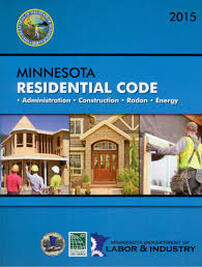Follow Us x
SECTIONR 310
EMERGENCY ESCAPE AND RESCUE OPENINGS
R310.1 Emergency escape and rescue required.
Basements, habitable attics, and every sleeping room shall have at least one operable emergency escape and rescue opening. Where basements contain one or more sleeping rooms, emergency egress and rescue openings shall be required in each sleeping room, but not be required in adjoining areas of the basement. Where emergency escape and rescue openings are provided they shall have a sill height of not more than 44 inches (1118 mm) measured from the finished floor to the bottom of the clear opening. Where a door opening having a threshold below the adjacent ground elevation serves as an emergency escape and rescue opening and is provided with a bulkhead enclosure, the bulkhead enclosure shall comply with Section R310.3. The net clear opening dimensions required by this section shall be obtained by the normal operation of the emergency escape and rescue opening from the inside. Emergency escape and rescue openings with a finished sill height below the adjacent ground elevation shall be provided with a window well in accordance with Section R310.2. Emergency escape and rescue openings shall open directly into a public way, or to a yard or court that opens to a public way.
Exceptions:
A.Constructed prior to August 1, 2008;
B.Undergoing an alteration or repair; and
C.The entire basement area, when all portions of the means of egress to the level of exit discharge, and all areas on the level of exit discharge that are open to the means of egress is protected with an automatic sprinkler system in accordance with IRC Section P2904 or NFPA 13D.
1.Basements used only to house mechanical equipment and not exceeding total floor area of 200 square feet (18.58 m2).
2.Basements or basement bedrooms when the building is protected with an automatic sprinkler system installed in accordance with IRC Section P2904 or NFPA 13D.
3.Basements or basement bedrooms that comply with all of the following conditions:
R310.1.1 Minimum opening area.
All emergency escape and rescue openings shall have a minimum net clear opening of 5.7 square feet (0.530 m2).
Exception: Grade floor openings shall have a minimum net clear opening of 5 square feet (0.465 m2).
R310.1.2 Minimum opening height.
The minimum net clear opening height shall be 24 inches (610 mm).
R310.1.3 Minimum opening width.
The minimum net clear opening width shall be 20 inches (508 mm).
R310.1.4 Operational constraints.
Emergency escape and rescue openings shall be operational from the inside of the room without the use of keys, tools, or special knowledge.
Exception: Windows with approved window opening control devices and installed in accordance with ASTM F 2090. The devices shall not require the use of keys or tools to operate.
R310.1.5 Replacement windows.
Replacement windows installed in buildings regulated by the International Residential Codeshall be exempt from the maximum sill height requirements of Section R310.1, including Subsections R310.1.1, R310.1.2, and R310.1.3, if the replacement window is the manufacturer's largest standard size window that will fit within the existing frame or existing rough opening. The replacement window shall be the same operating style as the existing window or a style that provides for an equal or greater window opening area than the existing window.
R310.1.5.1 Licensed facilities.
Windows in rooms used for foster care or day care licensed or registered by the state of Minnesota shall comply with the provisions of Section R310.1.5, or all of the following conditions, whichever is more restrictive:
- Minimum of 20 inches (508 mm) in clear opening width;
- Minimum of 20 inches (508 mm) in clear opening height;
- Minimum of 648 square inches (4.5 square feet) clear opening; and
- Maximum of 48 inches (1219 mm) from the floor to the sill height.
R310.2 Window wells.
The minimum horizontal area of the window well shall be 9 square feet (0.9 m2), with a minimum horizontal projection and width of 36 inches (914 mm). The area of the window well shall allow the emergency escape and rescue opening to be fully opened.
Exception: The ladder or steps required by Section R310.2.1 shall be permitted to encroach a maximum of 6 inches (152 mm) into the required dimensions of the window well.
R310.2.1 Ladder and steps.
Window wells with a vertical depth greater than 44 inches (1118 mm) shall be equipped with a permanently affixed ladder or steps usable with the window in the fully open position. Ladders or steps required by this section shall not be required to comply with Sections R311.7 and R311.8. Ladders or rungs shall have an inside width of at least 12 inches (305 mm), shall project at least 3 inches (76 mm) from the wall and shall be spaced not more than 18 inches (457 mm) on center vertically for the full height of the window well.
R310.2.2 Drainage.
Window wells shall be designed for proper drainage by connecting to the building's foundation drainage system required by Section R405.1 or by an approved alternative method.
Exception: A drainage system for window wells is not required when the foundation is on well-drained soil or sand-gravel mixture soils according to the United Soil Classification System, Group I Soils, as detailed in Table R405.1.
R310.3 Bulkhead enclosures.
Bulkhead enclosures shall provide direct access to the basement. The bulkhead enclosure with the door panels in the fully open position shall provide the minimum net clear opening required by Section R310.1.1. Bulkhead enclosures shall also comply with Section R311.7.8.2.
R310.4 Bars, grilles, covers and screens.
Bars, grilles, covers, screens or similar devices are permitted to be placed over emergency escape and rescue openings, bulkhead enclosures, or window wells that serve such openings, provided the minimum net clear opening size complies with Sections R310.1.1 toR310.1.3, and such devices shall be releasable or removable from the inside without the use of a key, tool, special knowledge or force greater than that which is required for normal operation of the escape and rescue opening.
R310.5 Emergency escape windows under decks and porches.
Emergency escape windows are allowed to be installed under decks and porches provided the location of the deck allows the emergency escape window to be fully opened and provides a path not less than 36 inches (914 mm) in height to a yard or court.
SECTION R311
MEANS OF EGRESS
R311.1 Means of egress.
All dwellings shall be provided with a means of egress as provided in this section. The means of egress shall provide a continuous and unobstructed path of vertical and horizontal egress travel from all portions of the dwelling to the exterior of the dwelling at the required egress door without requiring travel through a garage.
R311.2 Egress door.
At least one egress door shall be provided for each dwelling unit. The egress door shall be side-hinged, and shall provide a minimum clear width of 32 inches (813 mm) when measured between the face of the door and the stop, with the door open 90 degrees (1.57 rad). The minimum clear height of the door opening shall not be less than 78 inches (1981 mm) in height measured from the top of the threshold to the bottom of the stop. Other doors shall not be required to comply with these minimum dimensions. Egress doors shall be readily openable from inside the dwelling without the use of a key or special knowledge or effort.
R311.3 Floors and landings at exterior doors.
There shall be a landing or floor on each side of each exterior door. The width of each landing shall not be less than the door served. Every landing shall have a minimum dimension of 36 inches (914 mm) measured in the direction of travel. Exterior landings shall be permitted to have a slope not to exceed 1/4 unit vertical in 12 units horizontal (2-percent).
Exception: Exterior balconies less than 60 square feet (5.6 m2) and only accessible from a door are permitted to have a landing less than 36 inches (914 mm) measured in the direction of travel.
R311.3.1 Floor elevations at the required egress doors.
Landings or finished floors at the required egress door shall not be more than 11/2 inches (38 mm) lower than the top of the threshold.
Exception: The landing or floor on the exterior side shall not be more than 73/4 inches (196 mm) below the top of the threshold provided the door does not swing over the landing or floor.
Where exterior landings or floors serving the required egress door are not at grade, they shall be provided with access to grade by means of a ramp in accordance with Section R311.8 or a stairway in accordance with Section R311.7.
R311.3.2 Floor elevations for other exterior doors.
Doors other than the required egress door shall be provided with landings or floors not more than 73/4 inches (196 mm) below the top of the threshold.
Exception: A landing is not required if a stairway less than 30 inches (762 mm) in height is located on the exterior side of the door, provided the door does not swing over the stairway. The stairway height shall be measured vertically from the interior floor surface to the finished grade.
R311.3.3 Storm and screen doors.
Storm and screen doors shall be permitted to swing over all exterior stairs and landings.
R311.4 Vertical egress.
Egress from habitable levels including habitable attics and basements not provided with an egress door in accordance with Section R311.2 shall be by a ramp in accordance with Section R311.8 or a stairway in accordance with Section R311.7.


